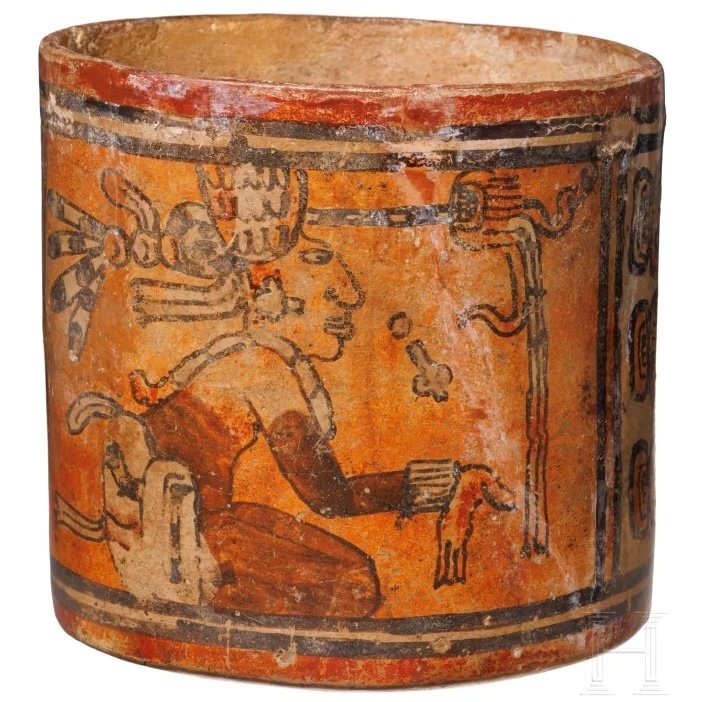Good seller: fast shipment, good packing and a very nice object. Thank you!
View translationMaya Ceramic Chamá Style Vessel depicting Two Seated Figures - 14.5 cm
No. 92191881



For a limited span of time, artists at sites in the Chamá Valley, located in the southern Guatemalan highlands, produced a specific form of pottery scholars call the "Chamá style." Chamá vessels were short-lived, limited in distribution, and appear to have always taken on the form of straight-sided vases and cups. They are frequently painted on an orange background and depict scenes bordered above and below with black and white chevron bands.
Description:
Cylindrical, hand-formed vase made of orange clay. On the outside, polychrome painting with a smoothed surface. Two similarly designed, rectangular picture areas with kneeling, forward-leaning warriors with rich feather decorations on their heads, separated by two registers with three Mayan glyphs each. Picture areas and glyph registers framed by black double lines. The largely similarly designed warrior pictures differ in the position of the hand stretched out in front. In one picture, the hand points upwards over a cylindrically shaped vase with contents indicated by dots (offering?), in the other picture the vase is missing and the hand points downwardsExtremely attractive vase from the late phase of the classical Mayan culture with only minor chips that do not affect the overall appearance of the artistically high-quality ceramic.
Several details identify this vessel as the work of the so-called "Chamá Master," the painter of a similar vessel currently in the collection of the Hudson Museum at the University of Maine at Orono and published on the Kerr Maya Vase Database as K7008. The most obvious identifier of this artist's work is the unusual way in which he paints the profiles of his subjects. The style in which the figures' eyes and jewelry, the feathers on their headdresses, and the codices in front of them are painted also closely match between these two vessels, confirming that a single artist's hand was at work.
Provenance:
- North Rhine-Westphalian private collection, acquired in 1992 in a French gallery on the occasion of the 500th anniversary of the discovery of America. Original brochure with a picture of the vase is enclosed.
- Acquired by the current owner at auction in 2004. Invoice enclosed.
For a limited span of time, artists at sites in the Chamá Valley, located in the southern Guatemalan highlands, produced a specific form of pottery scholars call the "Chamá style." Chamá vessels were short-lived, limited in distribution, and appear to have always taken on the form of straight-sided vases and cups. They are frequently painted on an orange background and depict scenes bordered above and below with black and white chevron bands.
Description:
Cylindrical, hand-formed vase made of orange clay. On the outside, polychrome painting with a smoothed surface. Two similarly designed, rectangular picture areas with kneeling, forward-leaning warriors with rich feather decorations on their heads, separated by two registers with three Mayan glyphs each. Picture areas and glyph registers framed by black double lines. The largely similarly designed warrior pictures differ in the position of the hand stretched out in front. In one picture, the hand points upwards over a cylindrically shaped vase with contents indicated by dots (offering?), in the other picture the vase is missing and the hand points downwardsExtremely attractive vase from the late phase of the classical Mayan culture with only minor chips that do not affect the overall appearance of the artistically high-quality ceramic.
Several details identify this vessel as the work of the so-called "Chamá Master," the painter of a similar vessel currently in the collection of the Hudson Museum at the University of Maine at Orono and published on the Kerr Maya Vase Database as K7008. The most obvious identifier of this artist's work is the unusual way in which he paints the profiles of his subjects. The style in which the figures' eyes and jewelry, the feathers on their headdresses, and the codices in front of them are painted also closely match between these two vessels, confirming that a single artist's hand was at work.
Provenance:
- North Rhine-Westphalian private collection, acquired in 1992 in a French gallery on the occasion of the 500th anniversary of the discovery of America. Original brochure with a picture of the vase is enclosed.
- Acquired by the current owner at auction in 2004. Invoice enclosed.
- 1
- 0
- 0
Good seller: fast shipment, good packing and a very nice object. Thank you!
View translation